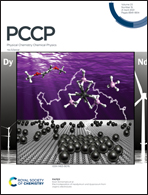Characterizing the lone pair⋯π–hole interaction in complexes of ammonia with perfluorinated arenes†
Abstract
When hydrogen is completely replaced by fluorine, arenes become prone to forming a lone pair⋯π–hole non-covalent bond with ligands presenting electron rich regions. Such a species is ammonia, which confirms this behavior engaging its lone pair as the electron donor counterpart in the 1 : 1 adducts with hexafluorobenzene and pentafluoropyridine. In this work, the geometrical parameters of the interaction have been unambiguously identified through the detection, by means of Fourier transform microwave spectroscopy, of the rotational spectra of both normal species and their 15NH3 isotopologues. An accurate analysis of the experimental data, including internal dynamics effects, endorsed by quantum chemical calculations, both with topological analysis and energy decomposition method, extended to the hydrogenated arenes and their water complexes, proved the ability of ammonia to create a stronger and more flexible lone pair⋯π–hole interaction than water. Interestingly, the higher binding energies of the ammonia lone pair⋯π–hole interactions correspond to larger intermolecular distances.



 Please wait while we load your content...
Please wait while we load your content...